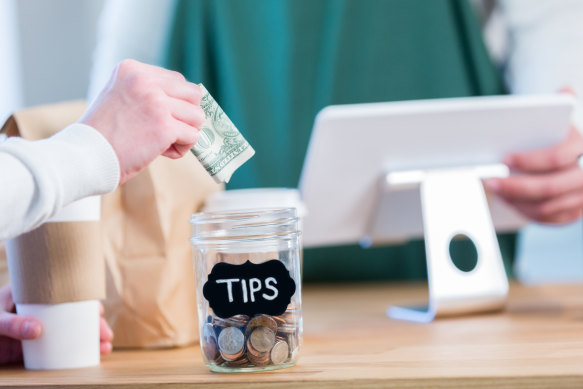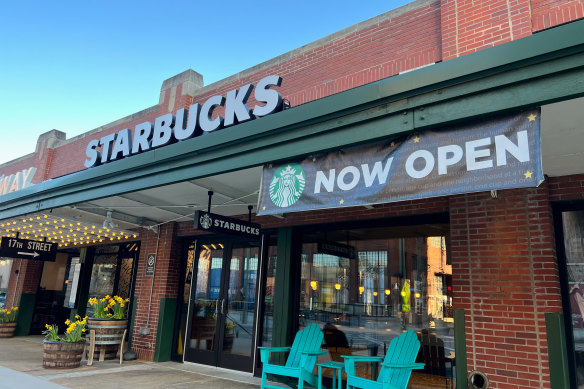Opinion
An extra 25 per cent at Starbucks? Tipping in US is out of control
By Simon Parker
Within an hour of touching down on American soil, I was faced with an iPad demanding a tip. The options? 18 per cent. 20 per cent. 25 per cent. No tip.
Should I really have to pay such an enormous gratuity for the pile of bland, beige mush I’d just been served, I wondered. I could have done with more time to ruminate, but the server loomed over me, with one eye on my bemused expression, and another on the long line of customers snaking around the block.

Tipping is now often expected in the US even for takeaway food or drinks.Credit: iStock
Jetlagged and discombobulated, I fumbled at the screen. No tip would be far too churlish, even by my foreign standards. So, I settled on a penny-pinching 18 per cent. But for the next 10 minutes, I ate soggy French fries with a sour taste in my mouth, wondering if I’d ever been given an 18 per cent bonus for simply doing my job. Or if I could recoup a few measly cents via an extra dollop of “complimentary” ketchup.
I’m used to adding around 10 per cent to the bill for great food and/or service. I also have no issue if there’s a reasonable service charge added to the balance – it can always be removed if the meal is a car crash.
Likewise, I sometimes drop a coin into the jar at my local coffee shop, and always round up a taxi fare. But was this “gratuity” really at my discretion? And what might have happened if I’d decided to refrain?
I’ve heard horror stories about tourists facing the wrath of waiters and bartenders. In March 2023, a disgruntled employee took to Twitter to shame a group of Europeans for leaving what was deemed a miserly 10 per cent tip ($US70/$A107) on their $US700 bill. And then in August 2024, reports surfaced of a male server confronting a lone female in her car, when she chose to leave no tip at all.

You will often find yourself presented with a tablet featuring several tipping options. Choosing “no tip” could lead to an altercation.Credit: iStock
But let’s just be 100 per cent clear: my transaction didn’t take place in a cosy diner, where I’d exchanged a “How are you?” and a “Have a nice day” with a smiley waitress in a pink pinnie carrying a steaming jug of coffee. No. This was at a fish-and-chip kiosk at Seattle’s Waterfront. No chairs, no tables, no chit-chat. Just a paper carton of fried potatoes, handed to me from behind a counter, with barely a word.
At the very start of a 6400-kilometre journey through pre-election USA, I had to remind myself to stop being so damn British – for fear of taking the shine off an otherwise epic adventure through a beautiful and surprising country. But even in the five-year interim since my last visit, America’s tipping culture had spiralled out of control.
As I cycled across the country, relying on gas stations and convenience stores for sustenance, I was flabbergasted to see that tips are (in some places) even being added to hardware, electronics and groceries. And that’s on top of a sales tax, which adds anywhere between 2.9 and 7.25 per cent at the cash register, depending on the state.
Nevertheless, within a few hundred kilometres I had decided to suck it up and toe the line. Because with 70 days’ cycling ahead of me, I had bigger chips to fry.

Even Starbucks is suggesting a tip of up to 25 per cent on your coffee.Credit: iStock
The age-old defence of the US tipping system goes something like: servers are (for some arcane reason) paid below minimum wage, therefore, they rely on tips to make up the shortfall. But why does this charge fall upon the consumer and not the employer? It’s not like the US is cheap any more, either. You’d be hard-pressed to find breakfast and coffee for less than $US20 these days – and that’s before you add taxes and tips.
One independent restaurateur told me that she couldn’t afford to operate her business if she paid her staff the national minimum wage of $US7.25 per hour. I found it impossible to believe. If this is the meagre profit margin of one of the planet’s most successful economies, then maybe we need to rethink our idea of wealth and prosperity.
But you know what really took the biscuit? Being prompted to pay a 25 per cent “tip” on an already grossly overpriced cup of “coffee” at a Starbucks in Oklahoma. Yes, that Starbucks. The global mega brand, worth $110 billion, which has faced intense scrutiny over its own tax arrangements in the past.
What next? Picking up the postage and packaging for Jeff Bezos’s Amazon deliveries? Or maybe we should all chip in and top up Elon Musk’s Lithium Ion-powered runaround?
You might think that tipping has the unwavering support of all Americans. It’s as ubiquitous in the land of stars and stripes as country music and the John Deere baseball cap. Think again.
According to a 2023 survey by the American personal finance website, Bankrate, two thirds of Americans have reached a tipping point, believing that the US approach to gratuities is spiralling out of control.
“We are a culture that is experiencing tipping fatigue,” says Diane Gottsman, National Etiquette Expert at The Protocol School of Texas. “We as a whole are feeling upset, frustrated, anxious, when we walk up to the counter and pay for a cup of coffee and then they turn the app around and they suggest tips that are almost equal to the cup of coffee.”
Gottsman believes that most Americans feel just as embarrassed about these new “tips” as many foreigners will do on their next US holiday.
“That tip is supposed to be discretionary, but it puts pressure on the consumer. We as consumers need to understand that we shouldn’t feel that pressure. The people behind us in the line are feeling that pressure and the people behind the counter feel the same pressure when they go buy a coffee or a bagel.”
So, what will I do on my next US holiday? In a diner, bar, or restaurant, I’ve decided to swallow my pride and cough up 20 per cent – “the sweet spot,” according to Gottsman. But when it comes to these new stealth tips, where my instinct is telling me a gratuity is ridiculous, I’ll hold my nerve, tap, and run.
How much should you tip?
According to Diane Gottsman, National Etiquette Expert at The Protocol School of Texas
Waiters/Waitresses: A minimum of 15 to 20 per cent is standard, and upwards for exceptional service.
Sommelier: If they help you choose a bottle, it’s appropriate to tip 10 to 20 per cent of the wine bill only.
When picking up take-out: Tipping is not required and is to be left to your discretion. However, if the server has bagged your order, added extra utensils or carried it out to your car, a tip is a nice gesture.
A bartender: If running a tab, tip 15 to 20 per cent of the bill, or $US1 to $US2 per drink. Dropping loose change in a jar when it amounts to a few cents is impolite.
Taxi drivers: A minimum of 15 per cent, or 20 per cent and above for a driver that assists you with your heavy luggage.
Uber and Lyft drivers: Select a preset amount or customise your tip. Similar to a taxi driver, 15 to 20 per cent is standard.
Restaurant delivery drivers: Tip your delivery driver 15 to 20 per cent of the total bill or $US5, whichever you prefer.
Hotel concierge: For quick directions to the nearest coffee shop, no tip is required. However, for acquiring easy theatre tickets or dinner reservations, tip $US5 to $US10, and $US20 upwards for difficult-to-secure tickets, reservations or special services.
Hotel housekeeping: A common mistake is to tip housekeepers at the end of the visit. It’s important to tip daily as employees change from one day to another, $US3 to $US5 per day. A good rule of thumb is $US1 per person staying in the room if there are multiple people.
The bellboy: Generally, $US1 to $US2 per bag, but if you only have one or two bags, make it worth the bellman’s trip and offer him $US5.
Hotel room service: Check the bill first to see if gratuity has already been added. If it has not been included, tip 15 to 20 per cent of the bill. It is not necessary to leave an additional tip for tray pick-up.
The valet: $US2 to $US5 dollars when they bring your car up to the curb.
Simon Parker’s new book is A Ride Across America: A 4000-mile adventure through the small towns and big issues of the USA.
The Telegraph, London
Sign up for the Traveller newsletter
The latest travel news, tips and inspiration delivered to your inbox. Sign up now.